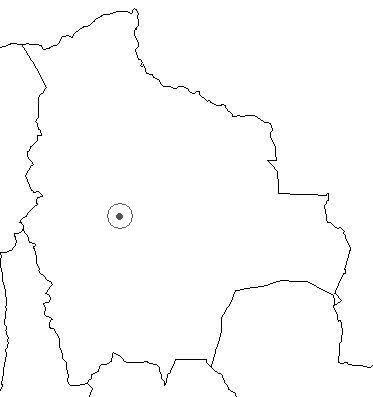- Bolivia, New South Wales
Infobox Australian Place | type = town
name = Bolivia
state = nsw

caption = Bolivia Hall with Bolivia Hill in the background.
lga = Tenterfield
county = Clive
postcode = 2372
est =
pop =
pop_footnotes=
elevation= 830
elevation_footnotes=
maxtemp =
mintemp =
rainfall =
stategov = Northern Tablelands
fedgov = New England
dist1 = 665
dir1 = N
location1=Sydney
dist2 = 306
dir2 = SW
location2=Brisbane
dist3 = 159
dir3 = N
location3= Armidale
dist4 = 61
dir4 = N
location4= Glen Innes
dist5 = 18
dir5 = NE
location5= DeepwaterBolivia is a locality on the Northern Tablelands in the New England region of
New South Wales ,Australia . The remains of the settlement comprises the former Bolivia Hotel, a disused post office, a disused railway siding and a community hall.History
The original inhabitants of the land were Aborigines of the
Kamilaroi clan. The first European settlement was in 1840, with the establishment of a sheep station owned by a squatter named Edward Hurry. Hurry had previously spent some years inBolivia inSouth America , and chose this name for the land around his property.cite web| title=Geographic Names Register:Bolivia| publisher=Geographical Names Board of New South Wales| month=October| year=1995| url=http://www.gnb.nsw.gov.au/name_search/extract?id=KWqwlMKm| accessdate=2007-11-22] Hurry’s sheep contracted catarrah and he sold Bolivia to SirStuart Donaldson who then held the property until 1843.During the 1880s a township developed towards the foot of Bolivia Hill as the railway was extended through the area. The town supported two bakeries, two butchers, two general stores, a produce store, a post and telegraph office and the railway offices, workshop and stables etc. The first school opened in 1883 and closed in 1886. Several other schools opened later and one was operating up until November 1966.
In 1981 the name Bolivia was assigned to the region covered by the various farms comprising Hurry's original estate, and is now an address locality for the farming properties scattered to the north and northeast of Deepwater.
The former Bolivia Hotel on the New England Highway has been listed on the
Register of the National Estate . [ [http://www.aussieheritage.com.au/listings/nsw/Bolivia/BoliviaHotelformer/2986 Aussie Heritage] ] This building was constructed c. 1840-1860 as a Cobb & Co. coach changing station and was later used as a post office and boarding house. Coach horses required regular changing about every 10 to 25km in order to provide quick transport. These hotels were known as a "Changing Station" and here passengers and horses could have something to eat or stay overnight.The Bolivia School of Arts building was erected 1914 on land donated by A.M. White of Bolivia Station. Many minerals have been mined in the region including
bismuth ,gold ,tin ,silver , high qualitysilica andarsenic .The Bolivia Cemetery was dedicated in July 1884 and officially closed in February 1986. This and the Bolivia Station Cemetery were used regularly until c.1900 but have had little use since then. No headstones remain and a few plants and depressions in the ground are the only indication of the cemetery there.
Geography
Bolivia occupies land to the north of Deepwater Creek and along both sides of Splitters Swamp Creek. A series of rough
granite outcrops dominate the landscape on either side of the creek beds.Little Bolivia Hill rises approximately eighty metres above Deepwater Creek on the southern boundary of the locality. The hill and adjacent nature reserve are the only recorded locations of the endangered Bolivia Hill Boronia ("
Boronia boliviensis ") [cite web| title=Bolivia Hill Boronia: Profile| publisher=New South Wales Department of Environment and Climate Change| month=September| year=2005| url=http://www.threatenedspecies.environment.nsw.gov.au/tsprofile/profile.aspx?id=10096| accessdate=2007-11-22] and the shrub "Pimelea venosa ." [cite web| title=Pimelia venosa| publisher=Commonwealth of Australia, Department of Environment and Water Resources| month=November| year=2007| url=http://www.environment.gov.au/cgi-bin/sprat/public/publicspecies.pl?taxon_id=16385| accessdate=2007-11-22]ports
Tennis, cricket, pigeon shooting,
polo and horse racing were among the popular sports that were held at Bolivia.Industries
Local industries include wine growing and beef cattle farms. In May 2001 a
Red Angus bull from Bolivia was sold for an Australian record price of $17,500. [cite web| title=Angus Record Prices at Auction| publisher=Angus Australia| year=2007| url=http://www.angusaustralia.com.au/M_Record_Prices.htm| accessdate=2007-11-22]Citations
References
Schiffmann, Paul; Fay McCowen; Debbie McCowen and Ken Halliday: “Bolivia – A Century and a Half”, Examiner Printing Service, Glen Innes, 1988
Wikimedia Foundation. 2010.
